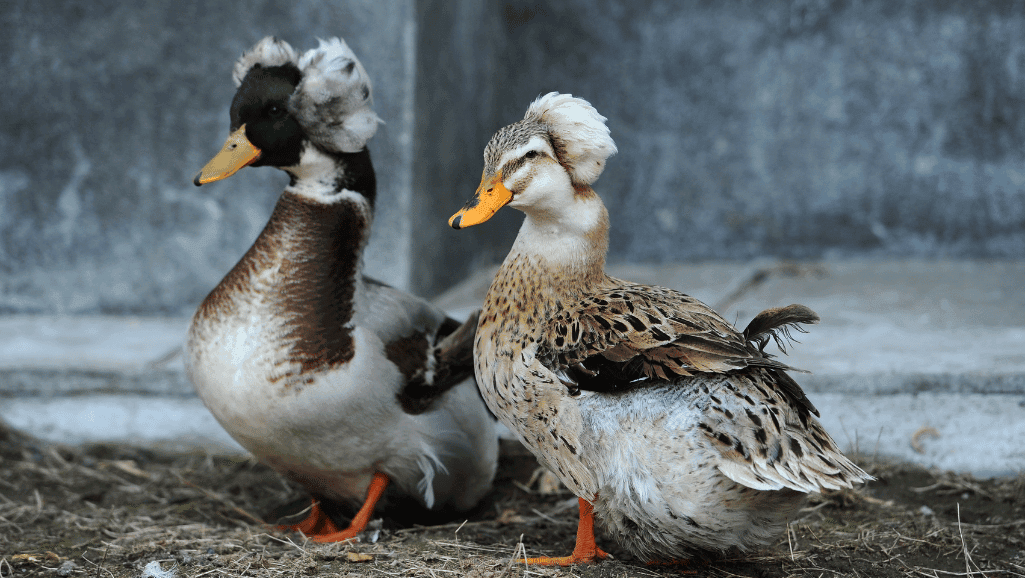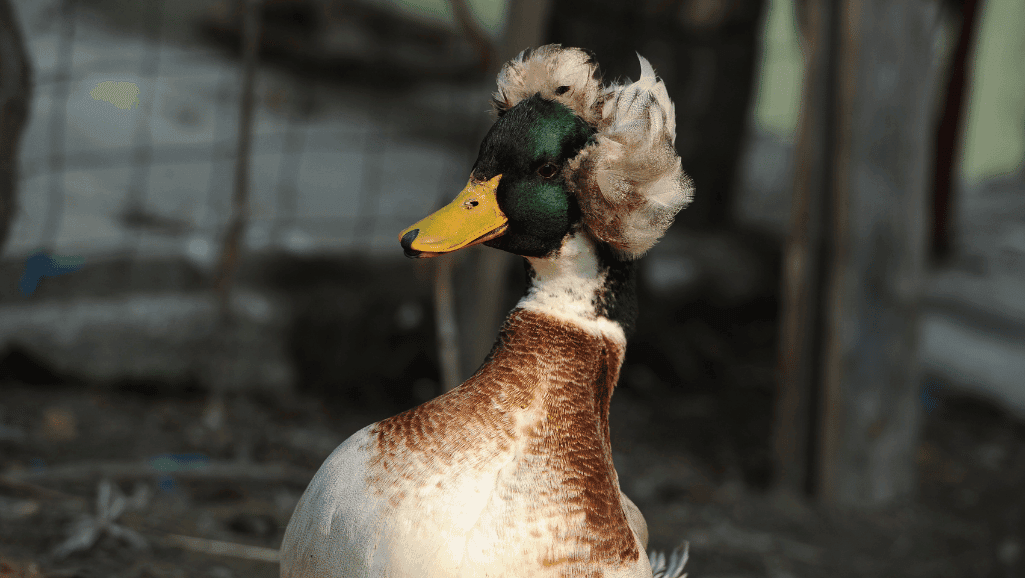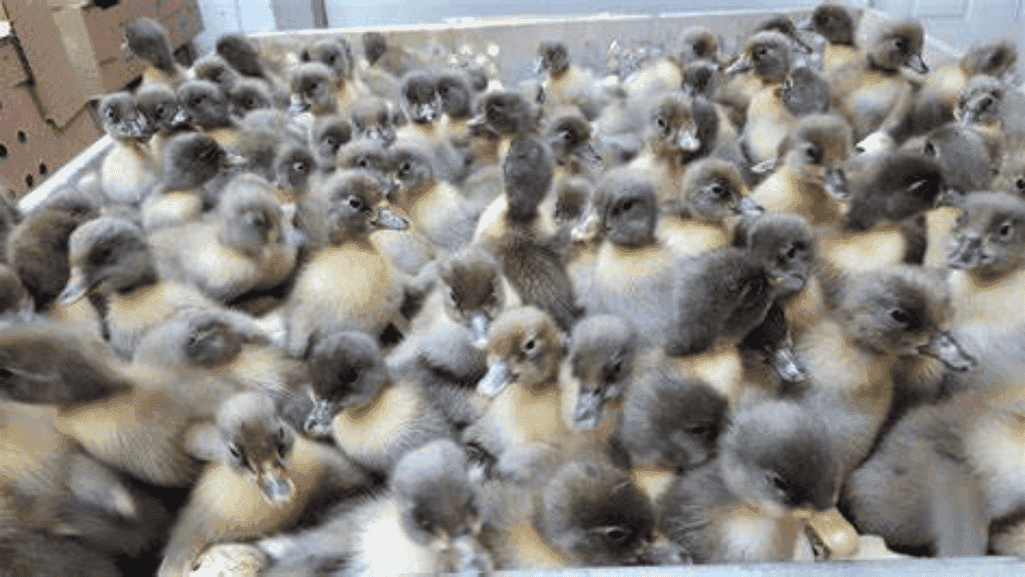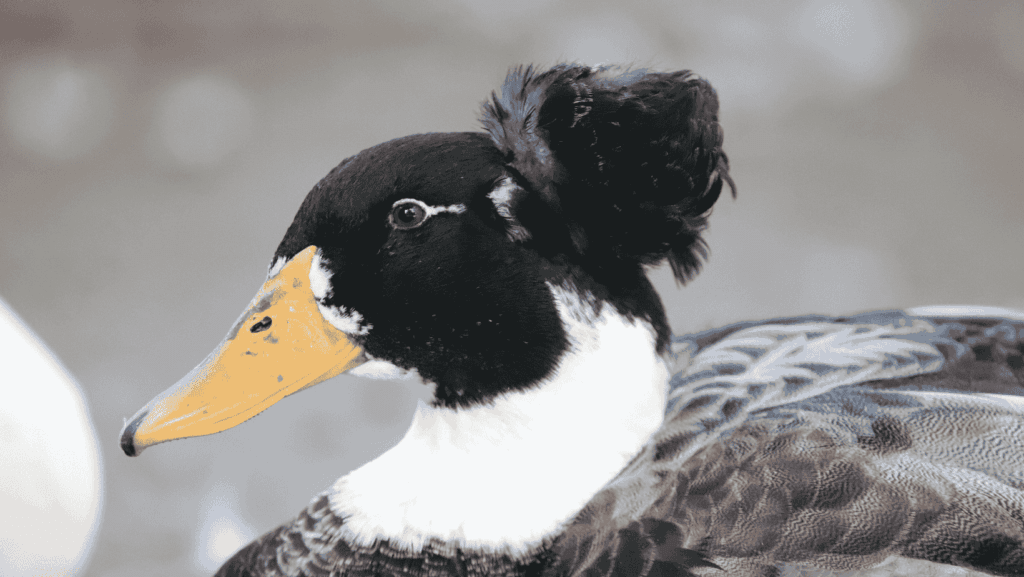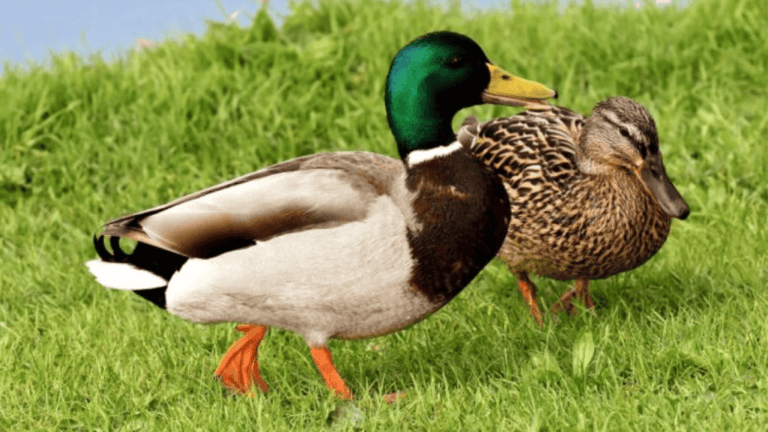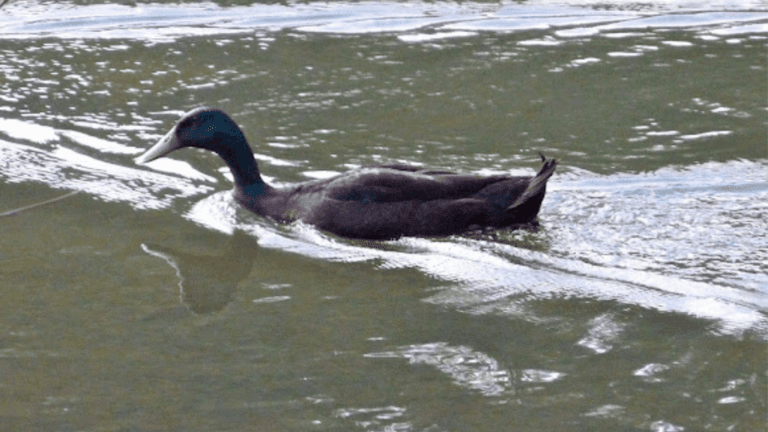Crested Blue Swedish Ducks are a unique sight in the world of waterfowl. They have a look that grabs the attention of both experts and casual viewers. Their blueish-gray feathers and distinctive crest make them stand out.
These ducks are more than just pretty. Crested Blue Swedish Ducks are friendly and adaptable, fitting well in many climates, especially cold ones. They are great pets for families and backyard flocks because they are so calm.
Despite their beauty, these ducks face big challenges. The Food and Agriculture Organization (FAO) said they were critical in 2007. The Domestic Animal Diversity Information System (DAD-IS) still sees them as at risk. This shows how important it is to breed and protect these ducks responsibly.
Key Takeaways
- Crested Blue Swedish Ducks are prized for their unique appearance
- They adapt well to cold climates and have a calm temperament
- The breed is currently classified as at-risk
- Male ducks weigh around 3.2 kg, while females weigh about 2.7 kg
- Only 30-40% of ducklings from specific matings develop crests
- The crest size can vary significantly, up to 13 cm in diameter
- Responsible breeding is crucial for the breed’s conservation
Introduction to Crested Blue Swedish Ducks
Crested Blue Swedish Ducks are a unique breed in the world of domestic ducks. They have captured the hearts of many avian hobbyists and fancy poultry keepers. Their special look and gentle nature make them a top pick for both new and seasoned duck owners.
Origin and History
The Crested Blue Swedish Duck comes from Germany. The American Poultry Association added them to their Standard of Perfection in 1904. These ducks are part of the Blue Swedish lineage, tracing back to at least 1835 in Pomerania, a region that was once part of Sweden.
Interestingly, Blue Swedish ducks are often mistakenly labeled. It’s said that 99% of ducks sold as Swedish have little to do with the true breed.
Distinctive Features
Crested Blue Swedish Ducks weigh between 6 to 8 pounds. Drakes are usually heavier than hens. Their crest on the head makes them stand out. They have a beautiful blueish-gray plumage.
These ducks are great at laying eggs, with hens producing up to 150 eggs a year.
Popularity Among Avian Hobbyists
The Crested Blue Swedish Duck is very popular among fancy poultry keepers. Their friendly nature and unique look make them perfect for backyard ponds and shows. Avian hobbyists love their toughness and ability to thrive in different climates.
With over 25 domestic duck species, the Crested Blue Swedish Duck is a top choice. It’s loved for its beauty and practical benefits, making it a favorite among duck lovers.
Physical Characteristics of Crested Blue Swedish Ducks
Crested Blue Swedish Ducks are known for their unique blueish-gray feathers. This color helps them hide from predators and fit into their environment. They are truly a beautiful sight among ornamental duck varieties.
Their crest is what makes them stand out. It’s a special feather on their head. The size of the crest can vary, from almost nothing to up to 13 cm wide. Sometimes, the crest gene can cause other physical changes, like shorter bodies or odd necks and tails.
These ducks are medium-sized. Drakes, or male ducks, usually weigh about 3.2 kg. Females, or ducks, weigh around 2.7 kg. If you’re looking at the bantam version, males weigh about 1.125 kg and females 0.9 kg.
| Characteristic | Description |
|---|---|
| Plumage Color | Blueish-gray |
| Distinctive Feature | Crest on head |
| Average Weight (Male) | 3.2 kg (standard), 1.125 kg (bantam) |
| Average Weight (Female) | 2.7 kg (standard), 0.9 kg (bantam) |
| Egg Colors | Blue, green, tinted, or white |
These ducks are not just beautiful; they’re also great at laying eggs. Hens can lay up to 150 eggs a year, most in spring and summer. The eggs come in blue, green, tinted, or white, making them perfect for both looks and use.
Breeding and Genetics of Crested Blue Swedish Ducks
Crested Blue Swedish Ducks are a unique breed in the fancy poultry world. Their special genes make them stand out among other domestic ducks. This makes them a hit with bird lovers.
Genetic Considerations
The genetics of Crested Blue Swedish Ducks are quite complex. The crest is caused by a genetic mutation that affects the skull. When breeding, it’s important to match crested ducks with non-crested ones to avoid health problems in their babies. The blue color comes from a dominant gene, leading to different colors in their offspring.
Breeding Challenges
Breeding Crested Blue Swedish Ducks comes with its own set of challenges. They have a lower fertility rate, between 60-75%, compared to other breeds. Breeders look for a small crest to avoid health issues. The best mating ratio is 7 females to 1 male for the best results.
Maintaining Breed Standards
Keeping the unique traits of Crested Blue Swedish Ducks is crucial. Breeders work hard to keep their blue eyes, yellow bills, and light orange feet. By carefully selecting who to breed, they ensure the breed stays true to itself while avoiding unwanted changes.
| Trait | Description |
|---|---|
| Egg Production | 100-130 extra-large eggs per year |
| Egg Weight | 80-90 grams |
| Egg Color | White with occasional blue or green tint |
| Body Weight | 6-7.25 lbs |
Understanding the complex genetics of Crested Blue Swedish Ducks is crucial for successful breeding. By following best practices and keeping up breed standards, enthusiasts help keep this unique duck breed alive.
Raising Crested Blue Swedish Ducks for Eggs and Meat
Crested Blue Swedish Ducks are great for backyard duck farming. They are excellent at laying eggs and producing meat. This makes them a top choice for homesteaders. They stand out among other domestic duck breeds.
These ducks are known for their egg-laying skills. They can lay 130-180 large to extra-large eggs every year. Most eggs are white, but some are gray, adding a bit of variety.
When it comes to meat, Crested Blue Swedish Ducks don’t disappoint. Males weigh about 8 pounds, and females weigh around 7 pounds. Their meat is tasty and tender, perfect for those who raise ducks for food.
| Trait | Crested Blue Swedish Ducks |
|---|---|
| Egg Production | 130-180 eggs per year |
| Egg Size | Large to Extra-Large |
| Egg Color | White (occasional gray) |
| Male Weight | 8 pounds |
| Female Weight | 7 pounds |
| Lifespan | 8-12 years |
Looking after Crested Blue Swedish Ducks is easy. They eat standard duck feed and love to forage. They are hardy and can live in many climates, fitting well into different backyard settings.
For those thinking about raising ducks, Crested Blue Swedish Ducks are a smart choice. They are productive and easy to manage. They are perfect for small-scale farmers wanting to add variety to their poultry.
Crested Blue Swedish Ducks as Ornamental Waterfowl
Crested Blue Swedish Ducks are a standout in ornamental duck varieties. Their unique look makes them a top pick for those who love fancy poultry. They add elegance to backyard ponds and waterfowl shows.
Aesthetic Appeal
Their beauty comes from their blueish-gray feathers and a special crest on their heads. This makes them stand out. The aesthetic appeal is huge among duck lovers.
Suitability for Backyard Ponds
These ducks do well in backyard ponds. They fit well in small spaces, making them great for home collections. They are calm, which is perfect for home settings. Hens weigh 6 lbs and drakes 7 lbs, so they’re just right for backyard spaces.
Exhibition and Show Potential
In fancy poultry shows, Crested Blue Swedish Ducks really shine. They’re in the Medium Weight group. Their crest and color make them a hit at shows. Duck fans and breeders love to show them off.
With the right care and attention, these ducks can do great in shows. Their unique look and calm nature make them popular among both new and seasoned show participants in ornamental duck varieties.
Care and Management of Crested Blue Swedish Ducks
Crested Blue Swedish Ducks are a delight for those who love birds and keep ducks at home. They are tough and love the cold, making them great for families with kids. Taking good care of them keeps them healthy and happy.
These ducks need lots of space to move around. They prefer to stay on the ground rather than on high perches. They also need clean water and a diet that meets their specific needs.
Brooding and Temperature Management
Keeping the right temperature is crucial when raising ducklings. Start with a temperature of 95°F for the first week, then drop it by 5°F each week until it reaches 45°F by week 10. Using heat plates is safer than lamps and feels like the warmth of a mother duck.
| Age (weeks) | Temperature (°F) | Space per Duckling (sq ft) |
|---|---|---|
| 0-1 | 95 | 1 |
| 2 | 90 | 1 |
| 3 | 85 | 1.5 |
| 4 | 80 | 2 |
| 5-10 | Decreasing to 45 | 2.5-3 |
Feeding them right is important for their growth. Ducklings need a diet high in protein, about 20-22%, which can be lowered to 18-20% after three weeks. Make sure they always have fresh water in deep containers for them to dip their bills.
If you’re showing your Crested Blue Swedish Ducks, getting ready is key. For shows, you’ll often need a pair. For market classes, you’ll need three ducks that match well.
Comparing Crested Blue Swedish Ducks to Other Domestic Duck Species
Crested Blue Swedish Ducks are unique among waterfowl breeds. They share traits with the Blue Swedish ducks but have their own special features. These make them stand out from other domestic ducks.
Similarities with Blue Swedish Ducks
These ducks have the beautiful blueish-gray feathers of their Swedish relatives. They are also strong and can live in many climates. Both breeds lay about 120-180 eggs a year, which is a good amount for domestic ducks.
Differences from Other Crested Breeds
Other crested ducks, like the White Crested and Black East Indian, also have fancy head feathers. But Crested Blue Swedish Ducks have a unique look. They lay fewer eggs than some other breeds, like the Khaki Campbells or Welsh Harlequins.
Unique Traits of Crested Blue Swedish Ducks
Their crest is what makes them special, unlike most domestic ducks. Even though they don’t lay as many eggs, they are great as decorative birds and pets. Their calm nature and beautiful looks make them favorites among bird lovers.


